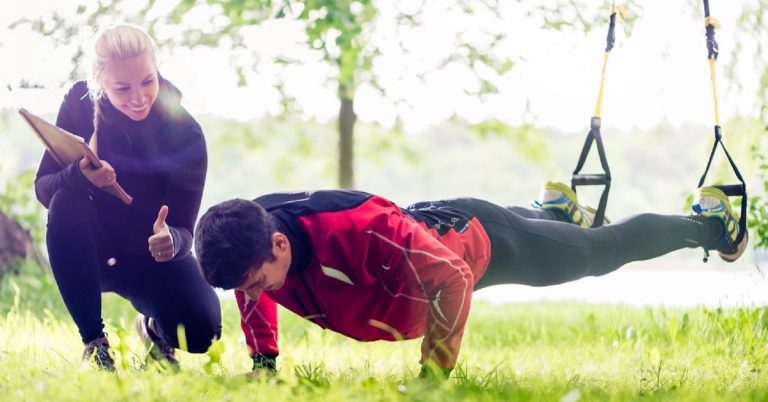There’s an art and science to spotting. Go to any gym and watch how personal trainers spot their clients—it quickly becomes clear that many have never been properly taught how to do it!
Here are six essential rules every trainer should follow when spotting clients:
Rule #1: Spot With Your Mouth First
Before using your hands, start with verbal cues. Words like “spread the floor,” “chest out,” or “chin up” can instantly correct form. With time, these can be condensed to single-word cues: “feet,” “chest,” “chin,” and so on.
As the client approaches fatigue, don’t rush in to help. Instead, use motivational cues like “speed!” or “drive!” to help them push through sticking points on their own.
How you deliver these cues matters. A quick, loud command conveys urgency and power. A calm, slow cue sends the opposite message—use it when you want control and precision. A firm “posture!” lets your client know you’re not tolerating sloppy reps.
Rule #2: Follow Safe Practices
If you’re putting your hands on the bar, ensure you’re in a stable, safe position—for both you and your client. For example, spotting the bench press with a double-supinated grip from the ground isn’t ideal with strong clients. You’re stronger deadlifting than curling, so stand on a platform and use a double-pronated grip instead.
Clear communication is critical. Say things like “Lift on three,” or “Do you have it?” before a set begins. And once the set is over, never let the client drop the bar before it’s securely racked—you don’t want dental bills or a slipped disc.
When possible, adopt a slight staggered stance for better balance—whether spotting a standing curl, machine chest press, chin-up, or overhead press. This gives you solid left-right and front-back stability.
Rule #3: Reduce the Assistance Over Time
Take chin-ups as an example: Start by supporting both feet. As your client gets stronger, hold only one foot (alternate each set). Eventually, provide a slight boost at the waist during the concentric (lifting) phase and let them lower themselves eccentrically on their own. This technique also works well for dips.

Rule #4: The Client Does the Work
You should only apply a small amount of force—no more than 5%—to help your client get past the sticking point. Your assistance should be smooth and fluid. Over time, you’ll develop a feel for when to help and how much.
Remember, the session is for your client, not for you. If you’re doing most of the lifting, the load wasn’t appropriate in the first place. Over-spotting not only undermines physical gains but also reduces your client’s confidence and independence.
One exception: When working with beginners, you may want to reduce or temporarily eliminate the eccentric phase on certain movements, then progressively introduce it—as I demonstrate on page 48 of The Elite Trainer. According to Dr. Tudor Bompa, this approach helps reduce soreness and retain new clients.
Rule #5: Stand in the Right Spot
Positioning matters. Don’t block your client’s range of motion. You should never have to ask, “Am I standing too close?”—especially during something like a semi-stiff-leg deadlift! Instead, stand to the side so you can monitor the bar path, knee angle, hip movement, and spinal alignment.
Try to stay out of your client’s direct line of sight. For exercises like the split squat, stand diagonally in front of your client to maintain visual access without disrupting their concentration. You can also use a resistance band around the forward knee and apply gentle inward or outward pressure to reinforce proper tracking.
Rule #6: Use Strategic Touch Methods
Touch techniques can help correct or activate certain muscles. A firm touch can wake up underactive muscles; a light touch can calm overactive ones. Many clients initially present with dominant upper traps and weak lower traps. Strategic touch can restore scapular balance during pulling exercises—as I demonstrate in my Stretch for Strength video.
Combining touch with imagery also works well. For example, during a lateral raise, tell your client to “fill the cup of your hand” with their elbow. Or touch their elbows and ears, and cue them to “draw a line between the two points” while leading with their elbows.
A great resource on this subject is Touch Training for Strength by Beth and Oscar Rothenberg.
Take-Home Message
Spotting is more than just helping with reps. It’s about reinforcing proper form, giving just enough assistance when needed, and coaching your client to move safely and effectively—on their own. Start with verbal cues, prioritize safety, and use strategic touch and positioning to elevate your client’s performance without doing the work for them.

Beyond Reps: The Trainer’s Hidden Effort
The role of a personal trainer goes far beyond counting reps or demonstrating exercises. Clients often underestimate how much energy

Guiding Personal Trainers to Success: A Comprehensive Resource
In the aftermath of the pandemic, many personal trainers have found themselves struggling to rebuild the business they once had.

Mastering the Craft: 10 Essential Rules Every Personal Trainer Must Follow for Success
Becoming a successful personal trainer requires more than just knowledge of exercises and anatomy—it demands professionalism, communication skills, and a
follow
Error: No feed with the ID 2 found.
Please go to the Instagram Feed settings page to create a feed.
